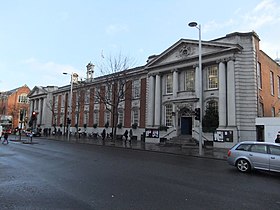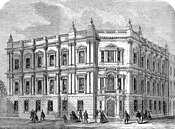|
Metropolitan Borough of Chelsea
The Metropolitan Borough of Chelsea was a metropolitan borough of the County of London between 1900 and 1965. It was created by the London Government Act 1899 from most of the ancient parish of Chelsea. Following the London Government Act 1963, it was amalgamated with the Royal Borough of Kensington in 1965 to form the Royal Borough of Kensington and Chelsea. Ecclesiastical parishThe ancient parish was originally dedicated to All Saints, but by the late 17th century it had been rededicated to St Luke. It was in the Diocese of London. In 1824 a new parish church was built in the centre of the parish, it was also dedicated to St Luke and the original parish church became a chapel-at-ease known as All Saints, Chelsea or Chelsea Old Church.[1] From 1831, as the population of Chelsea increased, a number of new parishes were formed:[2]
In the detached part of Chelsea parish, around the hamlet of Kensal Green (Kensal Town), a number of new parishes were also formed:[3]
Population and areaThe area of the borough was 660 acres (2.7 km2), once Kensal Town was transferred to Kensington and Paddington. The borough's only railway station was Chelsea & Fulham, on the West London Line, which closed in 1940. The borough's only tube station was Sloane Square.[4] The population recorded in the Census was: Chelsea Vestry 1801–1899
Metropolitan Borough 1900–1961
Coat of armsThe borough was granted a coat of arms by the College of Arms on 28 February 1903. The blazon was:
The winged bull is the symbol of St Luke, patron saint of Chelsea (St Luke's parish church is just off the King's Road). The other emblems referred to various holders of the manor over the centuries: the crozier for Westminster Abbey, the lion for Earl Cadogan (first mayor of the borough), the boars' heads and sword for the Sloane family and the stag's head for the Stanley family. The motto was Nisi dominus frustra or "It is vain without the Lord". The fourfold division of the shield was a design favoured by Albert Woods, Garter King of Arms for municipal grants: other examples in London included those of the metropolitan boroughs of Bermondsey, Camberwell, Islington, Kensington and Southwark. Politics Under the Metropolis Management Act 1855 any parish that exceeded 2,000 ratepayers was to be divided into wards; as such the incorporated vestry of St Luke Chelsea was divided into four wards (electing vestrymen): No. 1 or Stanley (9), No. 2 or Church (18), No. 3 or Hans Town (21) and No. 4 or Royal Hospital (12).[10] In 1894 as its population had increased the incorporated vestry was re-divided into five wards (electing vestrymen): Stanley (12), Church & Cheyne (15), Hans Town (12), Royal Hospital (9) and Kensal Town (12).[11][12] The metropolitan borough was also divided into five wards for elections: Cheyne, Church, Hans Town, Royal Hospital and Stanley.[13][14] Borough councilThe borough council was controlled by the Municipal Reform Party, which was allied to the Conservative Party, from its creation until 1949. In that year, the "Municipal Reform" label was discarded, and the Conservative party governed the borough until the borough's abolition in 1965. Chelsea Town Hall, a neo-classical building containing frescos, remains in use. It is situated on King's Road, at the corner of Chelsea Manor Street. Parliament constituencyFor elections to parliament, the borough formed a single constituency. By 1950, the decline in population meant that the Chelsea constituency also included the Brompton area of the Metropolitan Borough of Kensington. References
Further reading
External links |
||||||||||||||||||||||||||||||||||||||||||||||||||||||||||||||||||||||




